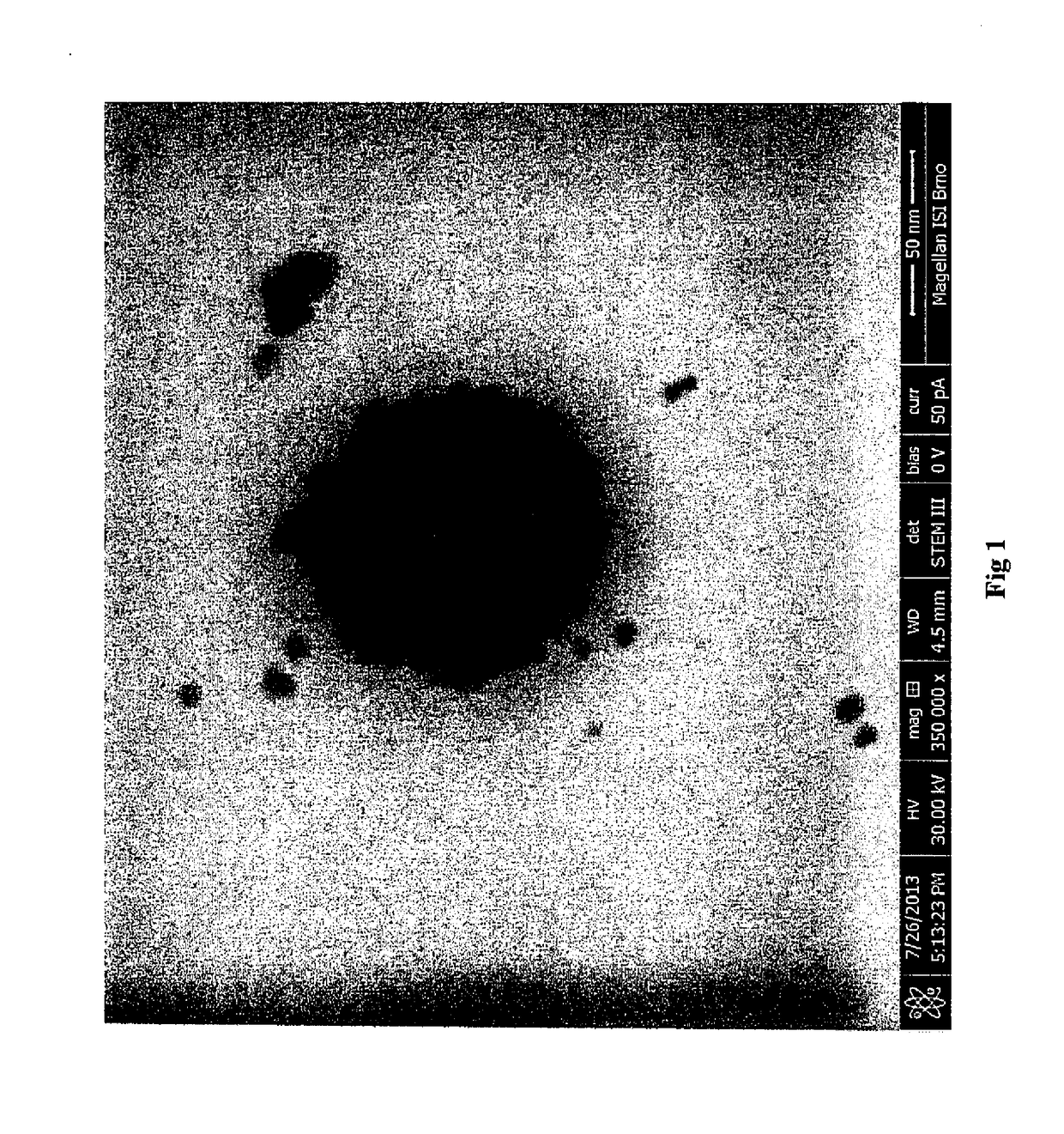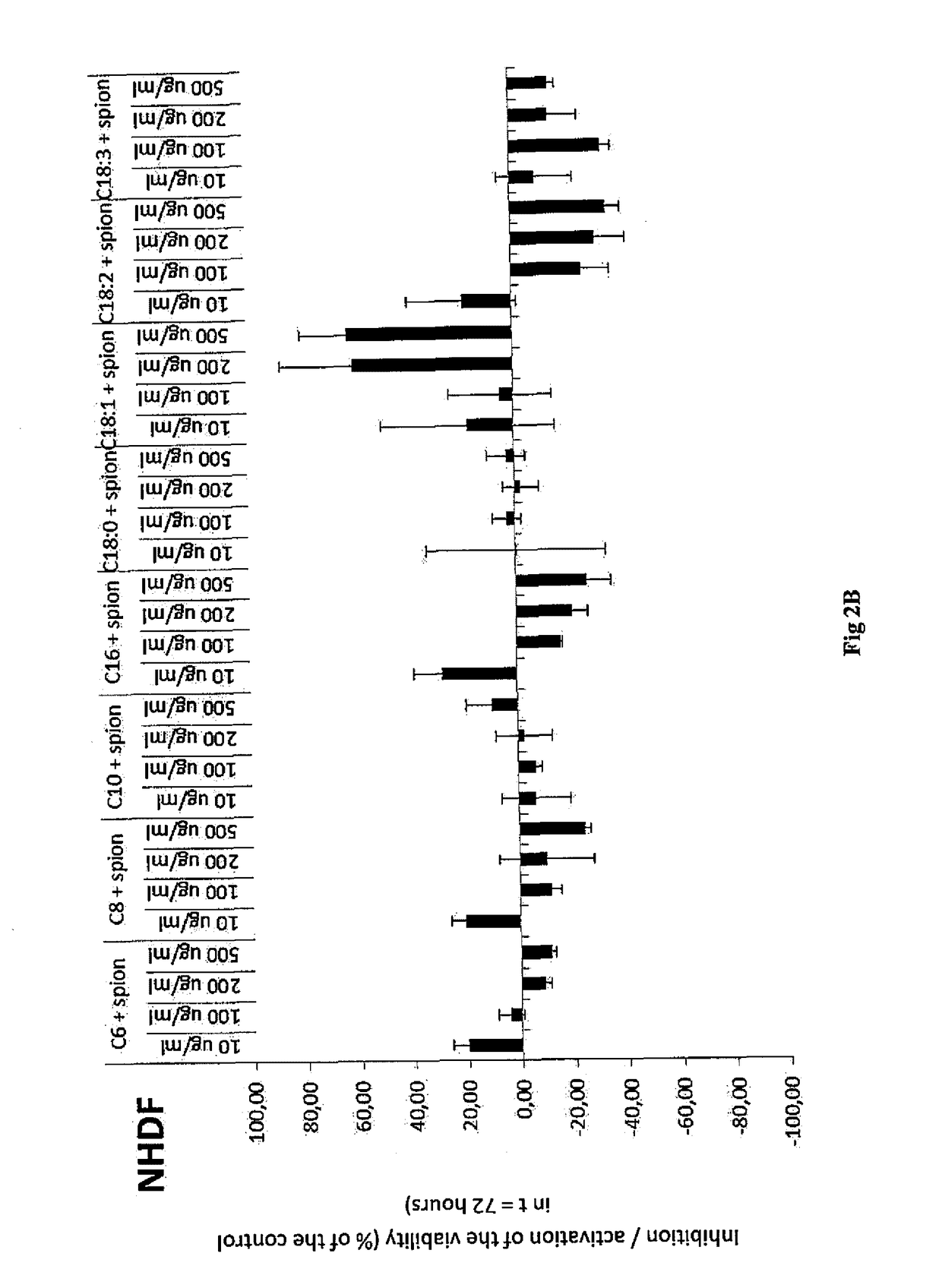Antitumor Composition Based on Hyaluronic Acid and Inorganic Nanoparticles, Method of Preparation Thereof and Use Thereof
a technology of inorganic nanoparticles and antitumor substances, which is applied in the field of antitumor compositions based on hyaluronic acid and inorganic nanoparticles, method of preparation thereof, can solve the problems of reducing the effectivity of therapy, toxicity of antitumor drugs not only in the area of tumorous disease, but also in the area of healthy tissues and cells, and achieves selective activity and increased expression of cd44 receptors
- Summary
- Abstract
- Description
- Claims
- Application Information
AI Technical Summary
Benefits of technology
Problems solved by technology
Method used
Image
Examples
example 1
Preparation of Hydrophobized Hyaluronic Acid, More Specifically the Oleyl Derivative (C18:1) of Hyaluronic Acid by Means of Mixed Anhydride of Benzoic Acid and Oleic Acid
[0049]100 g of sodium hyaluronan (250 mmol, 15 kDa) were dissolved in 2000 ml of demi water. Then 1000 ml of isopropanol were gradually added. Thereafter, TEA (70 ml, 3 eq.) and DMAP (1.52 g, 0.05 eq.) were added to the solution. At the same time, oleic acid (35.3 g 0.5 eq) was dissolved in 1000 ml of isopropanol, then TEA (70 ml, 3 eq.) and benzoyl chloride (14.4 ml, 0.5 eq.) were added to the solution. After the activation of the acid the precipitate was filtered off into the prepared HA solution. The reaction proceeded for 3 hours at room temperature. Then the reaction mixture was diluted by 1000 ml of demi water with an addition of 95 g of NaCl. The acylated derivative was isolated from the reaction mixture by precipitation by using a quadruple of absolute isopropanol. After decantation, the precipitate was repe...
example 2
on of SPIONs Having an Average Size of 5 nm
[0054]1.80 g of ferric oleate, 0.35 ml of oleic acid and 13.35 ml of 1-octadecene were added into a three-necked flask having the volume of 50 ml. The mixture was slowly heated under vacuum to 100° C., where it was maintained for 30 minutes for drawing away the volatile components. Then the mixture was heated under a mild argon flow to 280° C. and it was maintained at this temperature for 60 minutes. The mixture was bubbled through with argon during the reaction at 280° C. After cooling down to the room temperature, acetone was added to the reaction mixture and the nanoparticles were separated by centrifugation. The precipitated SPIONs were thereafter washed 4 times with a mixture of hexane / acetone (the ratio successively 1:4 to 1:1) and finally, they were dispersed in toluene and stored at 4° C. in dark.
Yield: 78%
[0055]Size of the nanoparticles: 5.2 t 0.8 nm (according to the photo from the electron microscope)
example 3
on of SPIONs Having an Average Size of 10 nm
[0056]1.80 g of ferric oleate, 0.35 ml of oleic acid and 13.35 ml of 1-octadecene were added into a three-necked flask having the volume of 50 ml. The mixture was slowly heated under vacuum to 100° C., where it was maintained for 30 minutes for drawing away the volatile components. Then the mixture was heated under a mild argon flow to the boiling point (˜317° C.) and it was maintained at this temperature for 60 minutes. After cooling down to the room temperature, the SPIONs were separated in the same way as in Example 2.
Yield: 74%
[0057]Size of the nanoparticles: 9.8±0.5 nm (according to the photo from the electron microscope)
PUM
| Property | Measurement | Unit |
|---|---|---|
| size | aaaaa | aaaaa |
| size | aaaaa | aaaaa |
| size | aaaaa | aaaaa |
Abstract
Description
Claims
Application Information
 Login to View More
Login to View More - R&D
- Intellectual Property
- Life Sciences
- Materials
- Tech Scout
- Unparalleled Data Quality
- Higher Quality Content
- 60% Fewer Hallucinations
Browse by: Latest US Patents, China's latest patents, Technical Efficacy Thesaurus, Application Domain, Technology Topic, Popular Technical Reports.
© 2025 PatSnap. All rights reserved.Legal|Privacy policy|Modern Slavery Act Transparency Statement|Sitemap|About US| Contact US: help@patsnap.com



